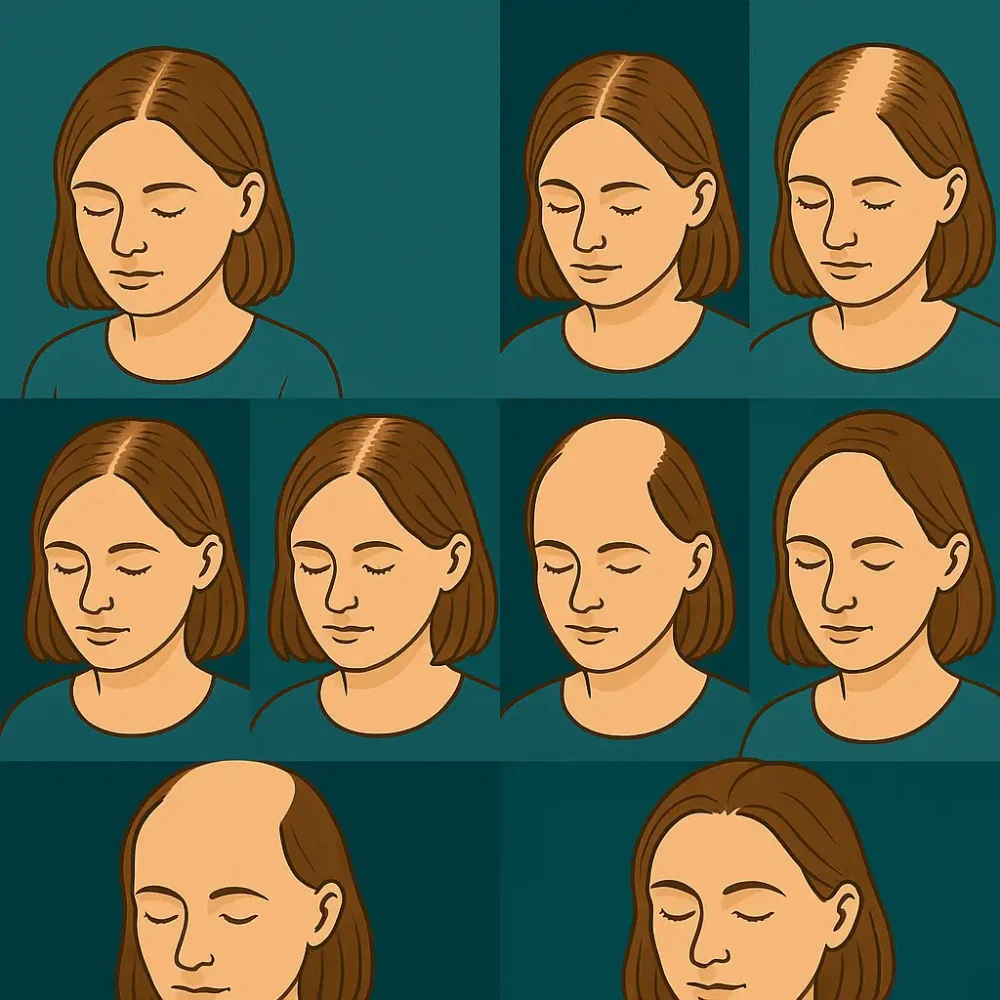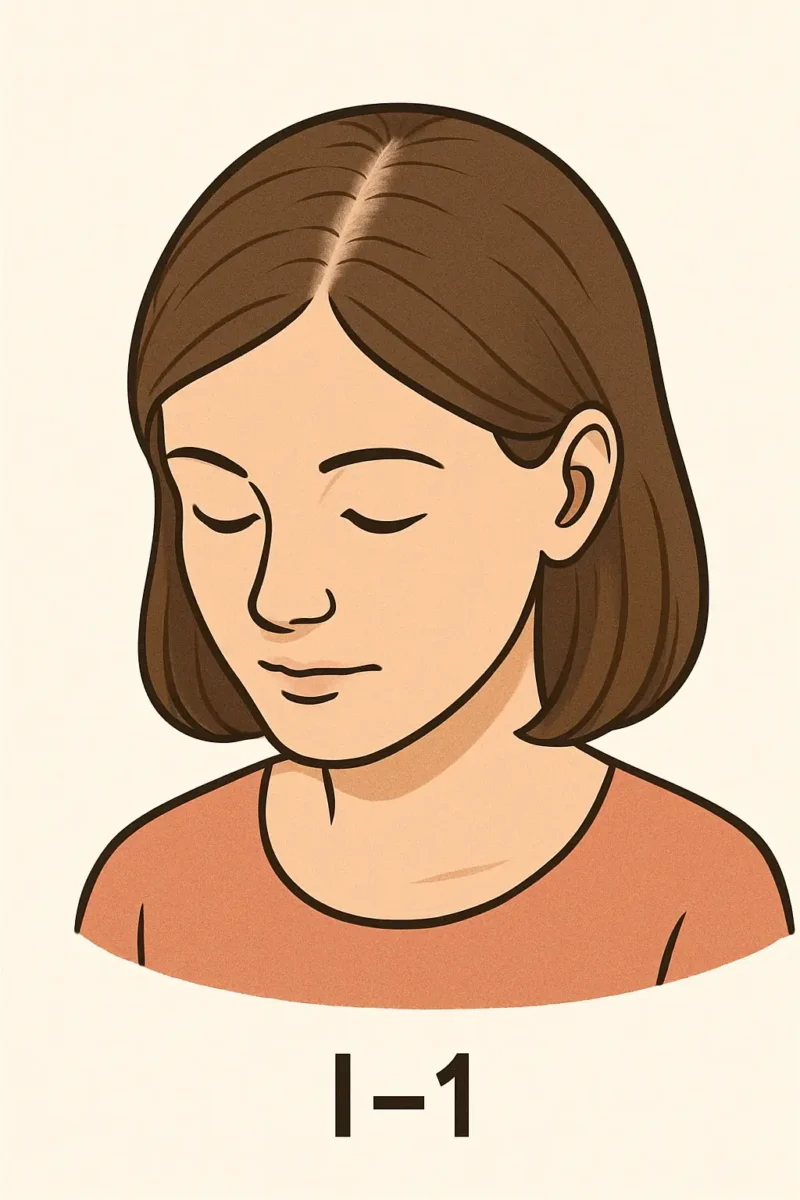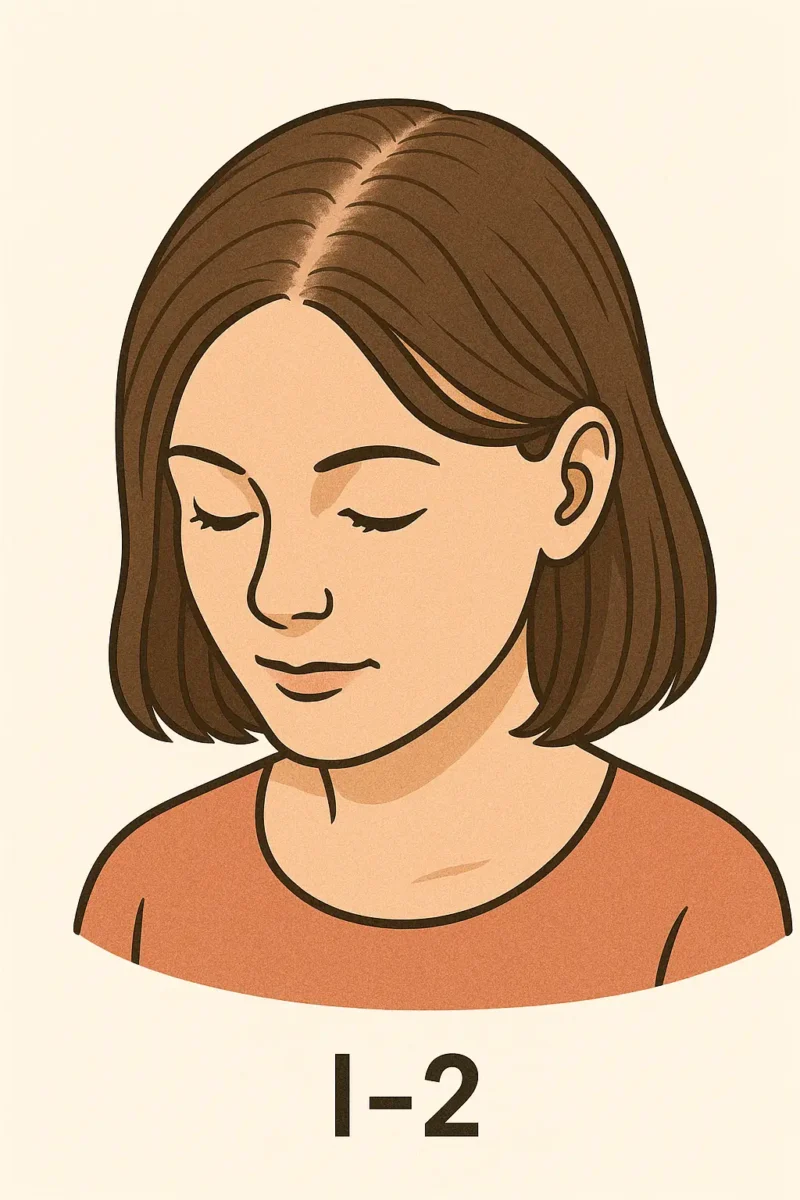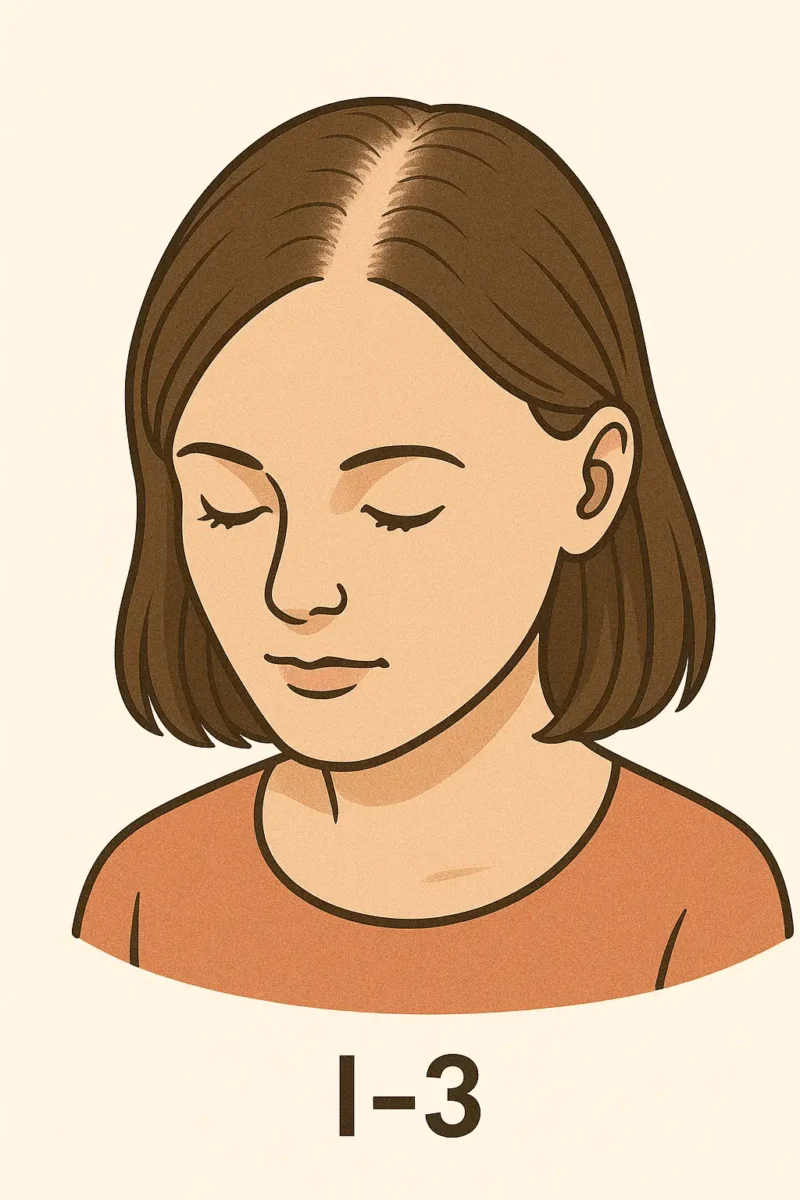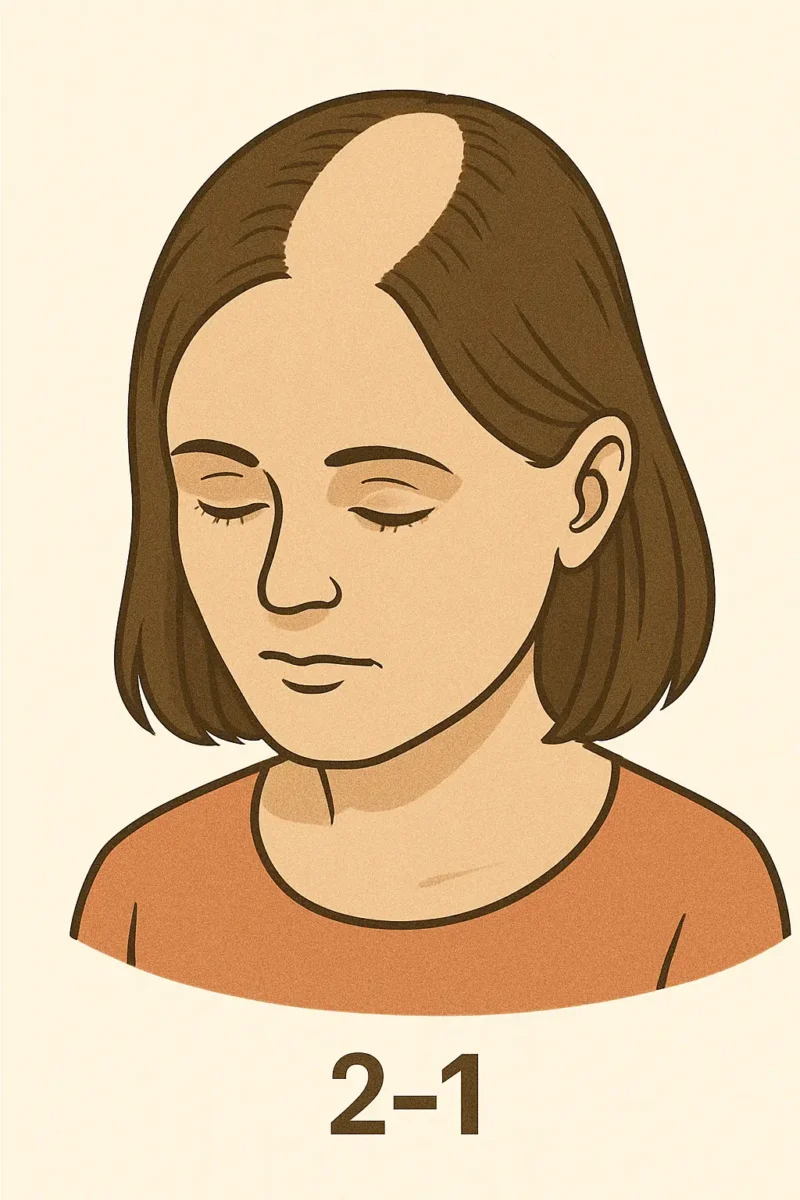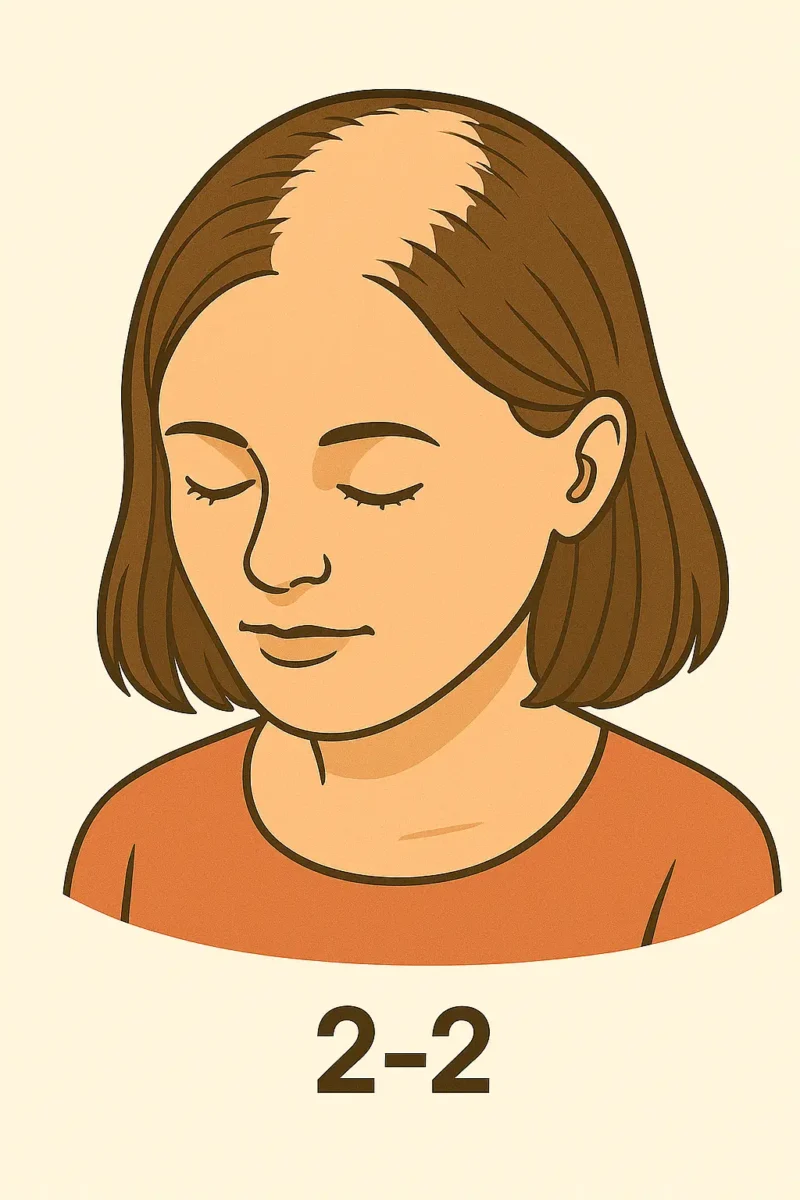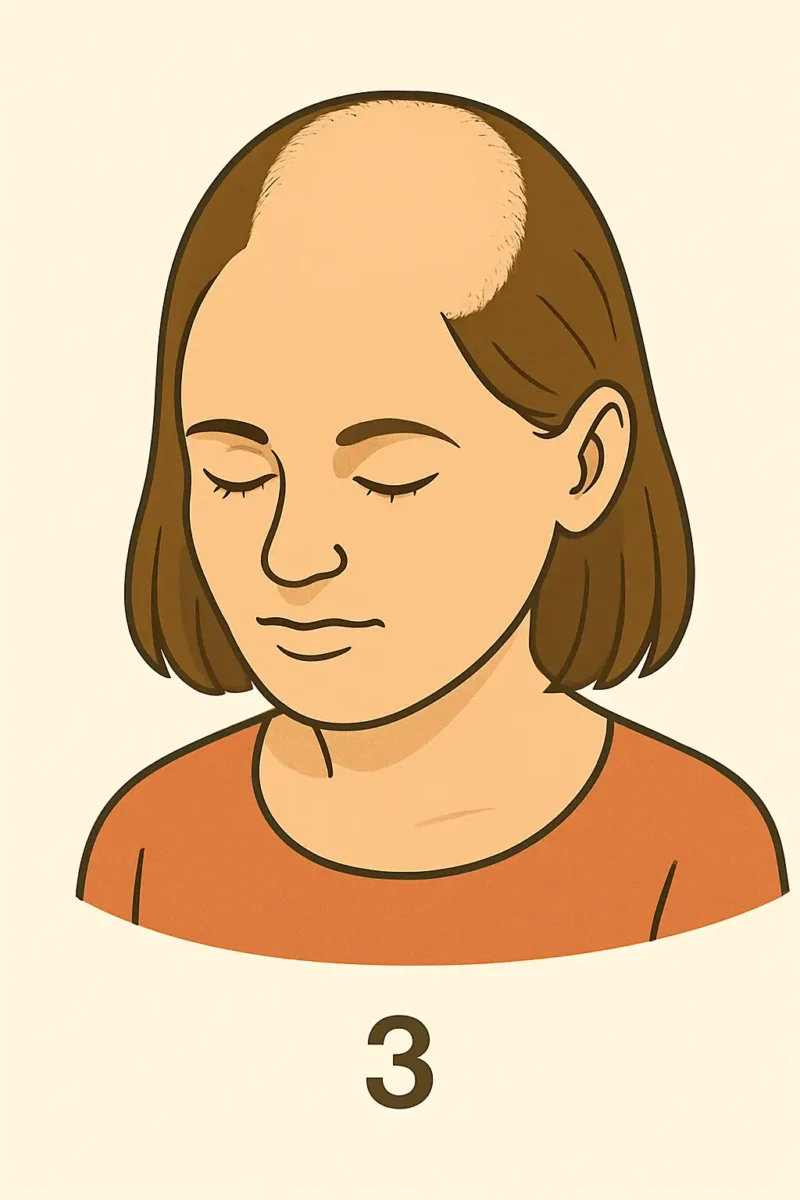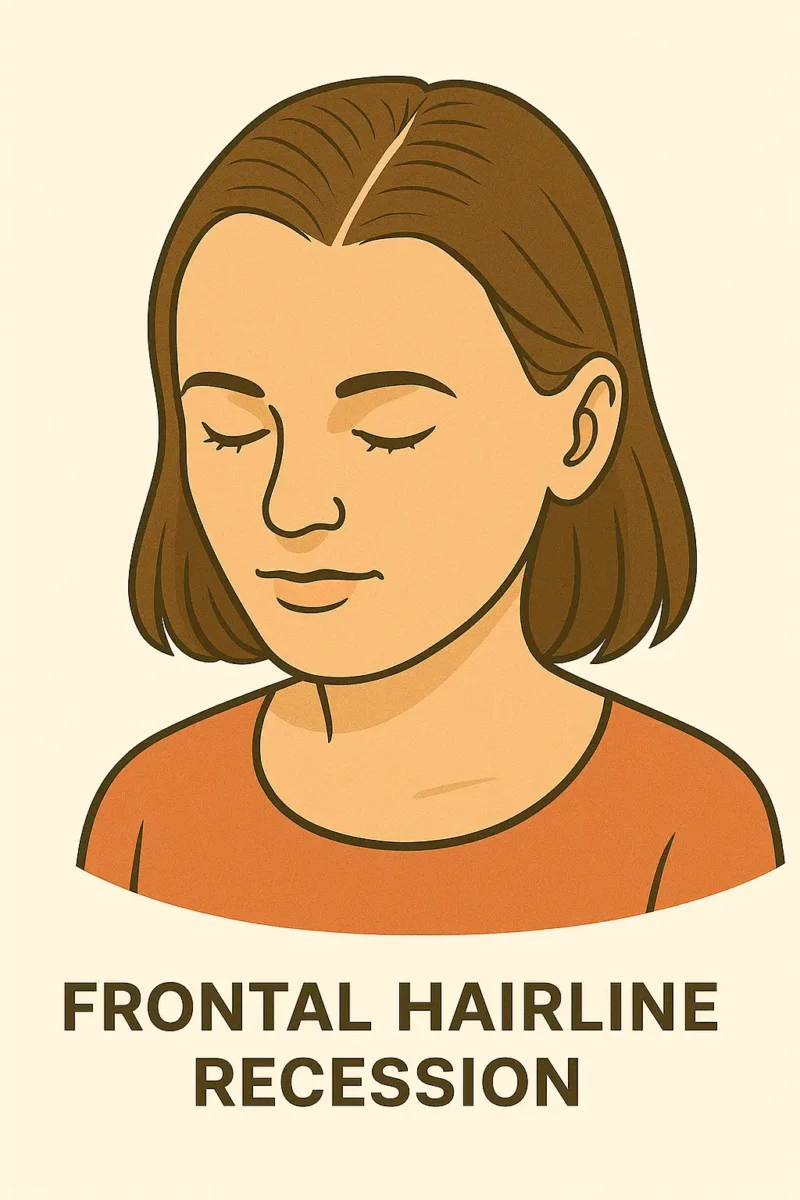Female hair loss, often diffuse thinning, can be a cause of extreme distress. Unlike male pattern baldness, it’s spread across the scalp, making diagnosis crucial. The Ludwig Scale standardizes classification for female pattern hair loss(female androgenetic alopecia), providing clarity for patients and doctors.
The History of the Ludwig Scale
The Ludwig Scale was developed by German dermatologist Dr. Erich Ludwig in 1977. The scale categorizes hair lossinto three stages, from mild to pronounced. This helps track progression and recommend treatments, including female hair transplant options. Before the Ludwig Scale, diagnosis for women was often less standardized, making consistent assessment and treatment difficult.
The Three Female Hair Loss Stages of the Ludwig Scale
The Ludwig Scale categorizes female pattern hair loss into three primary stages, each representing increasing severity of diffuse thinning on the crown of the scalp.
Ludwig Stage I: Subtle Thinning
This initial stage involves minimal hair loss, often unnoticed by others but visible to the individual. Hair thinning is mild and primarily affects the top of the head, particularly along the parting.
Ludwig Stage I-1
At this earliest point, the hair thinning is very mild, often only detectable upon close inspection. The central parting may appear slightly wider than usual, but overall hair density remains largely intact, and the scalp is not readily visible.
Ludwig Stage I-2
Here, the widening of the central parting becomes more noticeable, extending slightly from the front towards the crown. There is a perceptible, though still subtle, reduction in hair volume across the top of the scalp. While still manageable with styling, individuals may begin to observe less fullness or bounce in their hair.
Ludwig Stage I-3
In this subdivision, the thinning along the parting is clearly discernible, extending further back onto the mid-scalp. Hair volume is distinctly reduced, making the scalp more apparent, especially when hair is wet or pulled back. Despite this, the overall hair cover still provides significant concealment, and the scalp is not yet highly visible.
Ludwig Stage II: Moderate Thinning
At this stage, the hair loss becomes more evident. There is a significant reduction in hair density on the top of the scalp, making the scalp more visible through the hair, and styling becomes increasingly difficult to conceal the thinning.
Ludwig Stage II-1
The parting line is now significantly wider and more pronounced, extending further towards the crown. There is a definite and undeniable reduction in hair density across the entire mid-frontal scalp. It becomes challenging to style hair in a way that effectively camouflages the thinning.
Ludwig Stage II-2
This represents the peak of moderate thinning. There is pronounced hair loss across the entire top of the scalp, leading to a much higher degree of scalp visibility. The hair cover is sparse, making the underlying scalp clearly noticeable. The remaining hair may appear fine and limp.
Ludwig Stage III: Extensive Thinning
This is the most advanced stage, characterized by severe hair loss across the entire top of the scalp. The scalp is clearly visible, and the hair cover is very sparse. While significant, a complete bald area, as seen in men, is rare in women, and there is usually a rim of denser hair around the sides and back.
Frontal Hairline Recession: A Distinct Pattern in Women
While the Ludwig Scale primarily addresses diffuse thinning on the crown, some women experience a less common but distinct pattern of hair loss: frontal hairline recession. This involves a noticeable thinning or receding of the hair along the front of the scalp, similar to male pattern baldness.
This pattern is often indicative of a more pronounced hormonal sensitivity and can be particularly distressing as it directly impacts framing the face. While not part of the standard Ludwig Scale, it is an important variant that medical professionals consider during diagnosis, especially when discussing potential solutions like a targeted female hair transplant for hairline restoration.
Common Causes of Female Hair Loss
While the Ludwig Scale helps classify the pattern of hair loss, understanding the causes is crucial for effective treatment. Female hair loss is often multifactorial, meaning several elements can contribute to its onset and progression.
Category | Common Causes |
Genetics | Androgenetic Alopecia (inherited predisposition) |
Hormonal Imbalances | PCOS, Menopause, Thyroid disorders, Pregnancy |
Nutritional | Iron deficiency, Vitamin D deficiency, Zinc deficiency, Biotin deficiency |
Stress & Lifestyle | Telogen Effluvium (stress-induced shedding), Extreme dieting, Traction alopecia |
Medical Conditions | Autoimmune diseases (Alopecia Areata), Scalp infections, Chronic illness |
Medications | Certain contraceptives, Antidepressants, Blood thinners, Chemotherapy |
Genetic Predisposition
Androgenetic alopecia, or female pattern hair loss, is primarily genetic. If your mother or father experienced hair thinning, you are more likely to inherit the predisposition. It’s not always direct inheritance; sometimes it skips generations. Research indicates that genetics account for a significant percentage of female hair loss cases.
Hormonal Imbalances
Fluctuations in hormones are a major culprit. Conditions like Polycystic Ovary Syndrome (PCOS), characterized by excess androgens, can lead to hair thinning. Menopause and perimenopause also trigger hair loss due to declining estrogen levels. Thyroid disorders, whether hypothyroidism or hyperthyroidism, can severely impact hair growth cycles, leading to shedding. Pregnancy and postpartum periods can also cause temporary hair loss due to hormonal shifts.
Nutritional Deficiencies
A lack of essential vitamins and minerals can directly impact hair health. Iron deficiency, a common issue in women, is a leading cause of hair loss. Deficiencies in Vitamin D, zinc, and biotin also play a role in hair follicle function and overall hair density. A balanced diet is fundamental for healthy hair growth.
Stress and Lifestyle Factors
High levels of stress can trigger a condition called Telogen Effluvium, where a large number of hair follicles prematurely enter the resting phase, leading to widespread shedding. This often occurs a few months after a significant stressful event. Extreme dieting, rapid weight loss, or certain hairstyling practices that put tension on the hair (like tight ponytails or braids, known as traction alopecia) can also contribute to hair loss.
Medical Conditions and Medications
Underlying medical conditions, such as autoimmune diseases like Alopecia Areata (where the immune system attacks hair follicles), or scalp infections like ringworm, can cause localized or diffuse hair loss. Certain medications, including some oral contraceptives, antidepressants, blood thinners, and especially chemotherapy drugs, list hair loss as a known side effect. Consulting a doctor about all medications is crucial.
Diagnosing Female Hair Loss
When experiencing hair thinning, consulting a specialist, such as a dermatologist or a trichologist, is crucial. They will conduct a thorough evaluation to determine the type and cause of your hair loss.
The diagnostic process typically involves several steps:
- Detailed Medical History
- Physical Examination
- Hair Pull Test
- Blood Tests
- Scalp Biopsy (if necessary)
Effective Treatments for Female Hair Loss
Addressing female hair loss effectively requires a personalized approach based on the underlying cause and severity (as determined by the Ludwig Scale). A range of treatments is available, from non-invasive therapies to surgical solutions.
Medical Therapies
Several medical treatments are approved and commonly used to slow hair loss and stimulate new growth:
- Minoxidil (Topical):This is the most widely recognized over-the-counter treatment. Applied directly to the scalp, it works by prolonging the growth phase of hair follicles and increasing their size.
- Anti-androgens:For women whose hair loss is linked to elevated androgen levels (e.g., in PCOS), medications like Spironolactone may be prescribed. These work by blocking androgen receptors, reducing their impact on hair follicles. This is a prescription medication and requires careful medical supervision.
- Low-Level Laser Therapy (LLLT):Devices ranging from combs to caps use red light to stimulate hair follicles, reduce inflammation, and improve blood flow to the scalp. LLLT can be used at home and is considered safe and effective for many forms of hair loss.
Platelet-Rich Plasma (PRP) Therapy
PRP therapy involves drawing a small amount of your blood, processing it to concentrate the platelets, and then injecting this platelet-rich plasma into the scalp. Platelets contain growth factors that can stimulate dormant hair follicles, enhance hair thickness, and promote new hair growth. PRP is often used as a standalone treatment or in conjunction with other therapies for various types of hair loss.
Hair Transplant for Women
For women with localized thinning or those in later stages of the Ludwig Scale, a hair transplant offers a permanent solution. This surgical procedure involves extracting healthy hair follicles from a donor area (usually the back of the scalp, which is typically resistant to hair loss) and implanting them into the thinning or balding areas.
- DHI (Direct Hair Implantation)is a common technique used for women. This method leaves no linear scar and allows for a natural-looking result without shaving the patient’s head. The Long DHI technique, developed and practices by Dr. Serkan Aygin, allows for no head shaving at all.
How to Nurture Healthier Hair
Addressing hair loss effectively goes beyond just treatments; it also involves adopting a holistic approach to hair health.
- Seek Early Diagnosis: Don’t wait until hair loss is severe.
- Maintain a Balanced Diet: Ensure your diet is rich in essential nutrients.
- Manage Stress: Chronic stress significantly impacts hair cycles.
- Gentle Hair Care: Avoid harsh chemical treatments, excessive heat styling, and tight hairstyles.
- Regular Follow-ups: Consistency with your chosen treatment plan and regular check-ups with your specialist are vital.
- Educate Yourself: Understanding your specific type of hair loss and its causes.
Free Consultation with Dr. Serkan Aygin
If you are experiencing hair thinning or loss, a professional consultation can provide clarity and a tailored path forward. We invite you to schedule a free consultation with Dr. Serkan Aygin. We will propose therapies and offer a hair transplant in Turkey to permanently solve advanced hair loss cases.
FAQs
What is the difference between male and female hair loss?
Male pattern baldness often leads to complete baldness on the crown and frontal hairline. Female pattern hair loss, classified by the Ludwig Scale, usually presents as a diffuse thinning across the top of the scalp. Complete baldness is rare in women.
Can female hair loss be reversed?
While not always fully reversible, female hair loss can often be managed and significantly improved. Early diagnosis and consistent treatment can slow progression, stimulate new growth, and increase hair density. Some underlying causes, like nutritional deficiencies or thyroid issues, can lead to full hair recovery once addressed.
Is hair transplant for women effective?
Yes, hair transplant for women can be highly effective, especially for advanced Ludwig stages or frontal hairline recession. It offers a permanent solution, providing natural-looking and lasting results.
How long does it take to see results from treatment?
Results vary depending on the individual, the cause of hair loss, and the treatment method. Generally, it takes 3 to 6 months to notice initial improvements with medical therapies like Minoxidil or PRP. For hair transplants, visible growth typically begins around 3-4 months, with significant density appearing between 8-12 months, and full results by 12-18 months.

